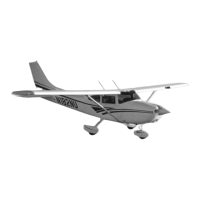SECTION 6 CESSNA
WEIGHT AND BALANCE/ MODEL T182T NAV III
EQUIPMENT LIST GFC 700 AFCS
U.S.
AIRPLANE WEIGHING PROCEDURES (Continued)
2. Level:
a. Place scales under each wheel (minimum scale capacity,
1000 pounds).
b. Deflate the nose tire and/or lower or raise the nose strut to
properly center the bubble in the level (Refer to Figure 6-1).
3. Weigh:
a. Weigh airplane in a closed hangar to avoid errors caused by
air currents.
b. With the airplane level and brakes released, record the
weight shown on each scale. Deduct the tare, if any, from
each reading.
4. Measure:
a. Obtain measurement A by measuring horizontally (along the
airplane centerline) from a line stretched between the main
wheel centers to a plumb bob dropped from the firewall.
b. Obtain measurement B by measuring horizontally and
parallel to the airplane centerline, from center of nosewheel
axle, left side, to a plumb bob dropped from the line between
the main wheel centers. Repeat on right side and average
the measurements.
5. Using weights from step 3 and measurements from step 4, the
Basic Empty Weight and C.G. can be determined by completing
Figure 6-1 (Sheet 2).
6. Changes to the Airplane Weight and Balance due to alteration or
repair must be documented in a permanent record within the
POH similar to that shown in Figure 6-2.
7. A new Basic Empty Weight and CG Arm based on actual
airplane weight (as weighed) is required after a major repair or
alteration. It is recommended that the airplane be weighed to
verify Basic Empty Weight and CG Arm at intervals not to
exceed 5 years.
T182TPHBUS-01
6-4

